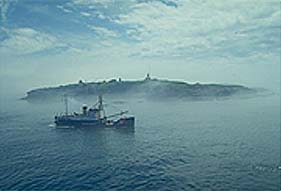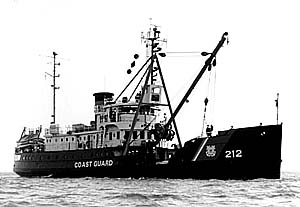
The USCG seagoing buoy tender is a type of United States Coast Guard Cutter used to service aids to navigation throughout the waters of the United States and wherever American shipping interests require. The U.S. Coast Guard has maintained a fleet of seagoing buoy tenders dating back to its origins in the U.S. Light House Service (USLHS). These ships originally were designated with the hull classification symbol WAGL, but in 1965 the designation was changed to WLB, which is still used today.

USCGC Sundew (WLB-404) is a 180-foot (55 m) sea going buoy tender (WLB). An Iris, or C-class tender, it was built by Marine Iron and Shipbuilding Corporation in Duluth, Minnesota, United States. Sundew's preliminary design was completed by the United States Lighthouse Service and the final design was produced by Marine Iron and Shipbuilding Corporation in Duluth for the U.S. Coast Guard. On 29 November 1943 the keel was laid. It was launched on 8 February 1944 and commissioned on 24 August 1944. The original cost for the hull and machinery was $861,589.

USCGC Alder (WLB-216) is the final Juniper-class, 225-foot (69 m) seagoing buoy tender of the United States Coast Guard.

A lighthouse tender is a ship specifically designed to maintain, support, or tend to lighthouses or lightvessels, providing supplies, fuel, mail, and transportation.

USCGC Cowslip (WLB-277) is a 180-foot (55 m) sea going buoy tender (WLB). A Cactus-class vessel, she was built by Marine Ironworks and Shipbuilding Corporation in Duluth, Minnesota. Cowslip's preliminary design was completed by the United States Lighthouse Service and the final design was produced by Marine Iron and Shipbuilding Corporation in Duluth. On 16 September 1941 the keel was laid. She was launched on 11 April 1942 and commissioned on 17 October 1942. The original cost for the hull and machinery was $918,873.
USCGC Spar (WLB-403) was a 180-foot (55 m) sea going buoy tender. An Iris class vessel, she was built by Marine Ironworks and Shipbuilding Corporation in Duluth, Minnesota. Spar's preliminary design was completed by the United States Lighthouse Service and the final design was produced by Marine Iron and Shipbuilding. On 13 September 1943 the keel was laid, she was launched on 2 November 1943 and commissioned on 12 June 1944. The original cost for the hull and machinery was $865,941.
USLHT Amaranth was a schooner-rigged, twin-screw, wooden-hulled lighthouse tender of United States Lighthouse Service, which served as a vessel of the United States Navy during World War I, and as part of the United States Coast Guard during World War II.

The United States Coast Guard Cutter Fir was the last lighthouse tender built specifically for the United States Lighthouse Service to resupply lighthouses and lightships, and to service buoys. Fir was built by the Moore Drydock Company in Oakland, California in 1939. On 22 March 1939, the U.S. Lighthouse Tender Fir was launched. She was steam driven with twin screws, 175 feet (53 m) in length, had a beam of 32 feet (9.8 m), drew 11 feet 3 inches (3.43 m) of water, and displaced 885 tons. Fir was fitted with a reinforced bow and stern, and an ice-belt at her water-line for icebreaking. She was built with classic lines and her spaces were lavishly appointed with mahogany, teak, and brass. The crew did intricate ropework throughout the ship. The cost to build Fir was approximately US$390,000. Fir's homeport was Seattle, Washington for all but one of her fifty one years of service when she was temporarily assigned to Long Beach, California when USCGC Walnut was decommissioned on 1 July 1982.

The second USS Suwannee and third USS Mayflower was a United States Lighthouse Board, and later United States Lighthouse Service, lighthouse tender transferred to the United States Navy in 1898 for service as an auxiliary cruiser during the Spanish–American War and from 1917 to 1919 for service as a patrol vessel during World War I. She also served the Lighthouse Board and in the Lighthouse Service as USLHT Mayflower from 1897 to 1898, from 1898 to 1917, and from 1919 to 1939, and in the United States Coast Guard as the first USCGC Mayflower (WAGL-236) in 1939 and from 1940 to 1943 and as USCGC Hydrangea (WAGL-236) from 1943 to 1945.
Two vessels of the United States Coast Guard have borne the name USCGC Greenbrier:

USCGC Fir (WLB-213) is a Juniper-class cutter of the United States Coast Guard. USCGC Fir is under the Operational Control (OPCON) of the Commander of the Thirteenth Coast Guard District and is homeported in Astoria, Oregon. Fir's primary area of responsibility is the coastal waters, river bars and high seas of the Washingtonian and Oregonian coasts. USCGC Fir conducts heavy lift aids to navigation operations, law enforcement and other missions as directed.
USCGC Mayflower may refer to more than one United States Coast Guard ship:
Three cutters of the United States Coast Guard have been named Willow
Three cutters of the United States Coast Guard have been named Kukui

USLHT Cedar was a lighthouse tender in commission in the fleet of the United States Lighthouse Service in 1917 and from 1919 to 1939, and – as USCGC Cedar (WAGL-207) – in the fleet of the United States Coast Guard from 1939 to 1950. She was in commissioned service in the United States Navy as the patrol vessel USS Cedar from 1917 to 1919 during and in the immediate aftermath of World War I. She also saw service in World War II under U.S. Navy control while in the Coast Guard fleet. She spent her career in the Pacific Northwest and the Territory of Alaska.

USLHT Camellia was a lighthouse tender in commission in the fleet of the United States Lighthouse Service from 1911 to 1917 and from 1919 to 1939, and – as USCGC Camellia (WAGL-206) – in the fleet of the United States Coast Guard from 1939 to 1947. During World War I she briefly saw war service with the United States Army in 1917 before serving as the United States Navy patrol vessel USS Camellia from 1917 to 1919. She also saw service in World War II under U.S. Navy control while in the Coast Guard fleet. After the conclusion of her United States Government career, she operated for decades in the service of the Dominican Navy as Capotillo.
USCGC Alder (WAGL-216) was a wooden-hull lighthouse tender in commission in the fleet of the United States Lighthouse Service as USLHT Alder from 1924 to 1939, and in the fleet of the United States Coast Guard as USCGC Alder from 1939 until 1948. During World War II, she was given the additional designation (WAGL-216).
USCGC Hemlock (WAGL-217) was a lighthouse tender in commission in the fleet of the United States Lighthouse Service as USLHT Hemlock from 1934 to 1939, and in the fleet of the United States Coast Guard as USCGC Hemlock from 1939 to 1958. During World War II, she was given the additional designation (WAGL-217).
USCGC Acacia can refer to the following ships of the United States Coast Guard:
This page is based on this
Wikipedia article Text is available under the
CC BY-SA 4.0 license; additional terms may apply.
Images, videos and audio are available under their respective licenses.









